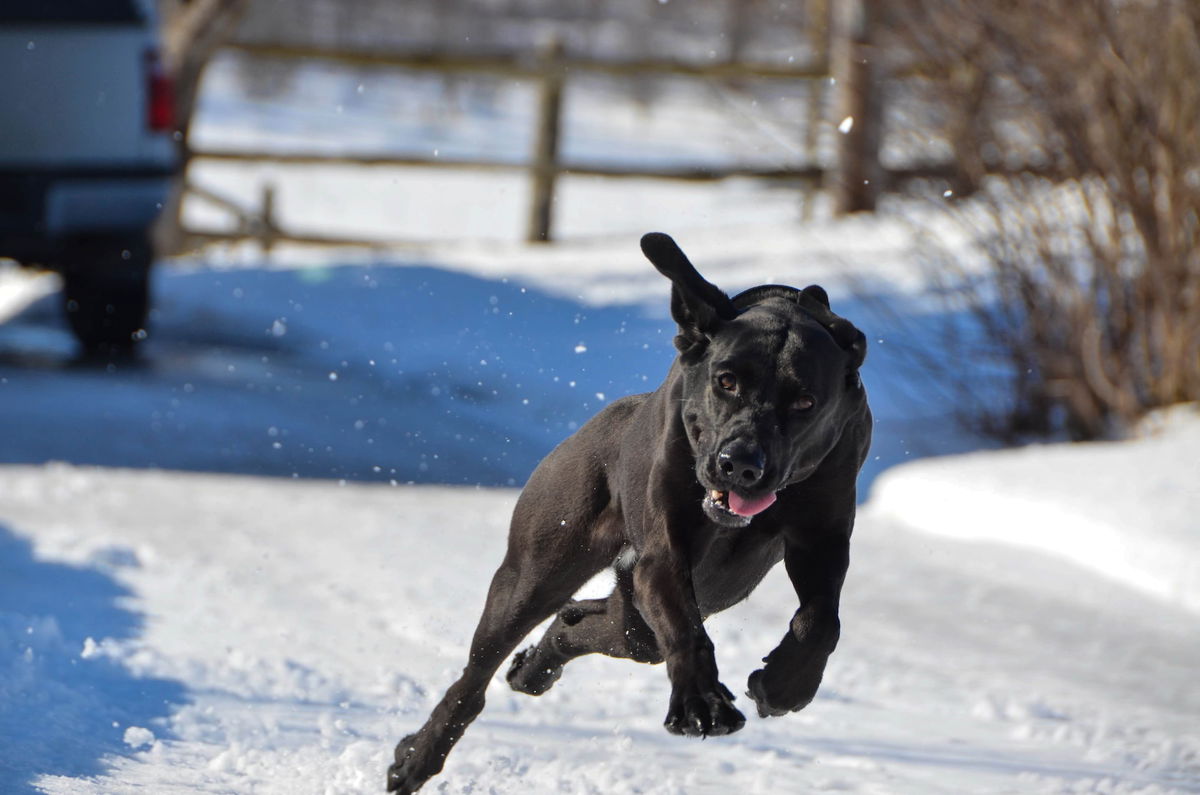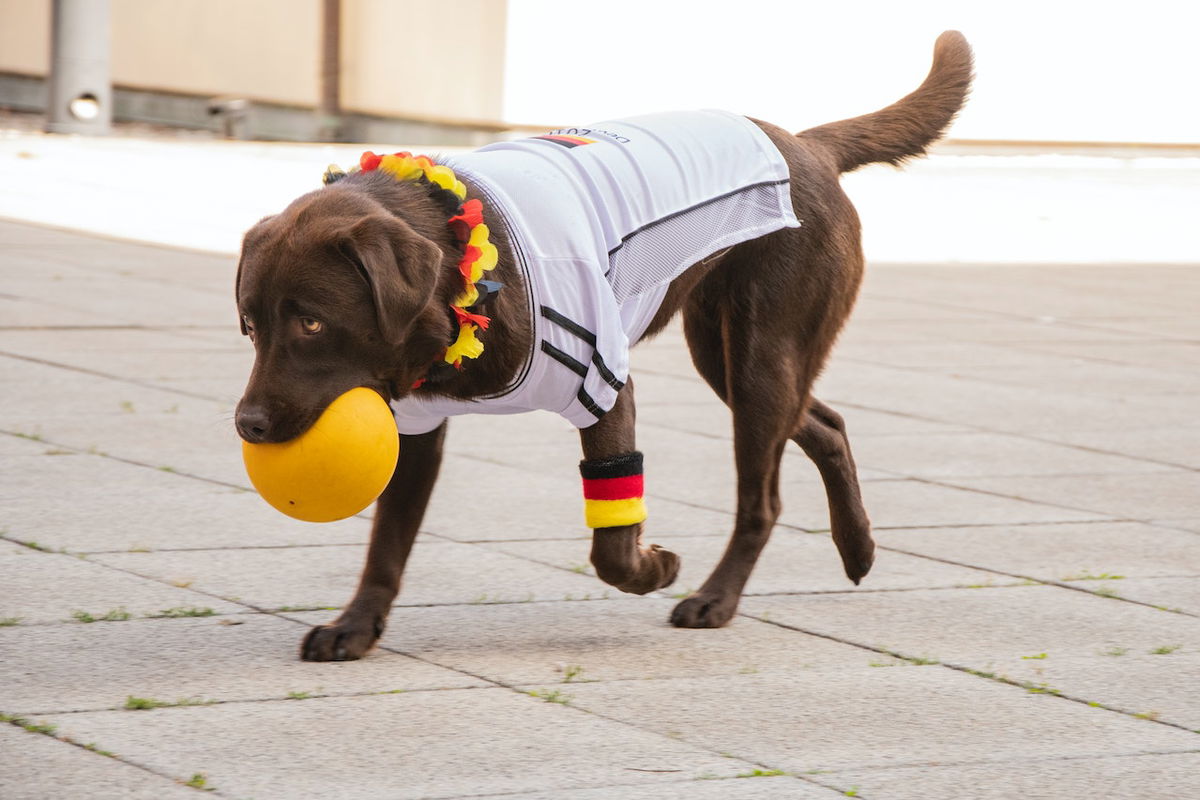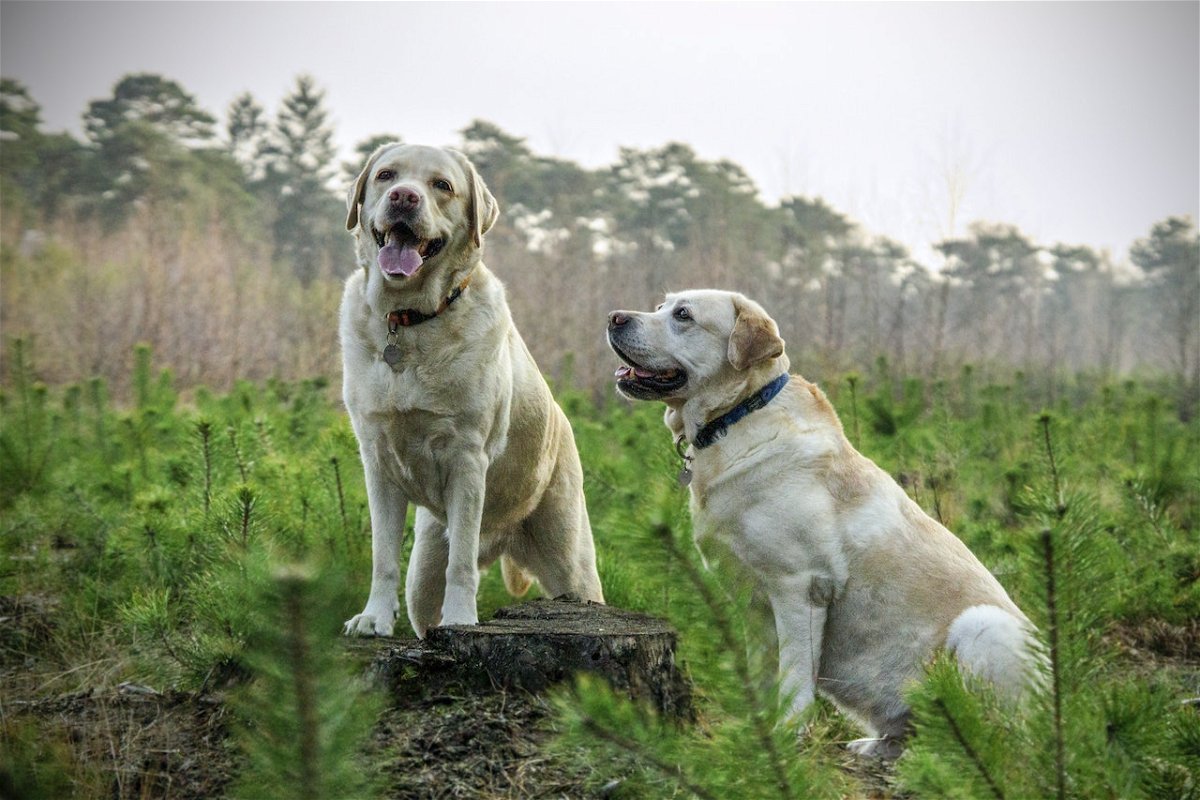We're an affiliate
We hope you love the products we recommend! Just so you know, we may collect a share of sales or other compensation from the links on this page at no additional cost to you. Thank you if you use our links, we really appreciate it!
Labrador Retrievers took the competitive spot as the most popular dog breed in America for 31 years in a row, until 2022 when they came second to the French Bulldogs.
The American Kennel Club (AKC), which provides yearly data on the most popular dog breeds, has attributed the exemplary performance of Labs to their lovable temperament and versatility.
There’s just so much we can talk about concerning Labrador Retriever dog breed. Keep reading our comprehensive guide to discover the details you may have missed about these canines.
What Is a Labrador Retriever? – Brief History of Labrador Retrievers
A Labrador Retriever is a British working dog breed. We can trace their history to the now-extinct Saint John’s water dog from Newfoundland, Canada where they assisted fishermen to pull fishing nets.
The dogs accompanied their handlers on fishing trips and undertook various tasks. They not only pulled heavy fishing nets from the water but they also dived to catch escaping fish.
British Aristocrats who visited Newfoundland during the 1800s were so blown away by the St. John’s water dogs that they brought immense praise about the dogs back home.
James Harris, the second Earl of Malmesbury heard about all the praises of the early St. John’s water dogs and requested some of them to be imported to the UK.
Despite being a parliamentarian, Harris was also involved in hunting and he had long desired to breed his own sporting dog with suitable qualities.

A few years later, Walter Scott – the 5th Duke of Buccleuch, also established a breeding kennel in Scotland and began rearing the St. Johns water dogs.
The first Labrador Retrievers were recognized by the English Kennel Club in 1903 as a breed. The American Kennel Club followed suit and inducted this dog breed in 1917.
A few years later, AKC released an article in their official gazette about Labs. They consequently became so popular and were imported into the US and Canada from the UK.
Present-day Labrador Retrievers are still used as working dogs as well as being part of the greater household community.
5 Fascinating Facts About Labrador Retrievers
1. Labrador Retrievers are one of the most beloved breeds in the world
According to data from the AKC, Labrador Retrievers have consistently ranked among the most popular dog breeds in the US for many consecutive years.
2. Labradors Retrievers love water
Labrador Retrievers’ love for water can never be ignored because these dogs were initially used by fishermen in high seas.
They are covered with a thick waterproof coat that can keep them protected under very icy conditions in water.
3. Labrador Retrievers were initially bred for hunting
The history of Labrador Retrievers dates back to the shores of Newfoundland, Canada where they assisted fishermen to pull heavily laden fish nets.
These dogs were later bred in the UK and they served as hunting companions for English noblemen in the 1800s.
4. Labrador Retrievers are gentle
Despite their robust appearance, Labrador retrievers are very gentle with their human companions and they can form special emotional connections when given the right treatment.
5. Labrador Retrievers excel in working roles
Labs have an inherent push to perform heavy tasks, thanks to their selective breeding history and impressive mental prowess.
They can serve in various fields and are among the most popular choices for search and rescue operations, drug detection, and therapy work.
Labrador Retriever Puppies
Most veterinarians recommend adopting a puppy when they are at least 8 weeks old. Some states have legislation regarding when and how to adopt a puppy.
Snatching a puppy from its mother before weaning can cause them to suffer a physical or mental breakdown due to abrupt changes in the environment.
Owning a Labrador Retriever puppy should be a rewarding experience yet one that is filled with uncertainties for some people.
Unlike most other dog breeds, adopting one Lab or two is never a worrying concern. This is because these dogs never rely on their fellow puppies or adult dogs for self-fulfillment.

These beloved young canines have a special way of filling their human caregivers with joy, thanks to their boundless energies and desire to please.
As a new puppy parent, you need to get ready for some sporting action to expand your young Lab’s high energy in positive outlets.
Labradors are highly social animals, and they can thrive when provided with plenty of attention from all the family members.
Be sure to spend some quality time cuddling and bonding with your Labrador puppy to show your love and get them well-adjusted to their environment.
Labrador Retriever Types
1. The American Labrador Retrievers
The American Labrador Retrievers were also raised in the United Kingdom, even though their name tries to suggest otherwise.
American Labrador Retrievers are sharper working dogs than their English counterparts, which has sometimes earned them the name ‘Field Labrador Retrievers’.
These dogs can play different working roles in farms and other labor-intensive setups.
The American Labs therefore are more athletic and muscular than the English type, and they also feature slightly more elongated extremities.

The temperament of American Labradors is closer to that of a typical working dog. They have high energy levels which puts them at an advantageous point to perform different working roles.
They are more reactive (not aggressive!) than the English Labs, meaning they’re more sensitive about their surroundings
These dogs have an acute hunting instinct, thanks to their selective breeding history.
We strongly recommend that you train and educate your American Lab to channel their inbuilt hunting instincts into healthy behaviors if you plan on adopting one of them into your family.
2. The English Labrador Retrievers
The English Labrador Retrievers (show type) are generally sturdier, heavier, and with blockier heads compared to their counterparts from America.
Since the English labs are bred for conformational purposes to appear in dog shows, they are less athletic compared to the other types.
Despite their heavy body build, British labs would typically have lower energy levels compared to the American Labrador Retrievers.

English labs mature slowly which makes them develop a fairly heavy body that can be prone to obesity when deprived of exercises
British Labrador retrievers have a very colorful and delightful temperament, which can be summed up in three words: friendly, affectionate, and playful.
Even though the British-type labs are not working dogs, they will need a little socialization and training to coexist peacefully with children.
Labrador Retrievers Physical Characteristics
Size and Weight range
A fully grown Labrador Retriever male dog can stand 22.5 – 24.5 inches from the ground while a female size ranges from 21.5 – 23.5 inches.
In terms of weight, a mature Labrador Retriever male dog can tip the scale within the range of 65 – 80 pounds while their female counterparts weigh 55 – 70 pounds.
Coat color and texture
The weatherproof coat of Labrador Retrievers is short, very dense, and without waves. Their special double coat should also give a fairly hard-feeling texture when rubbed with the hand.
Purebred Labrador Retrievers’ coat colors according to breed standards are black, yellow, and chocolate.
Black Labradors should be solid black; even though they often have snips of white markings, especially on the toes, paw pads, chest, and sometimes a single spot on the chin.
Distinctive features
One of the most distinctive features of Labrador Retrievers is their blocky head which gives an attentive yet friendly expression.
The beloved canines have a clean-cut head that is free from fleshy cheeks. You’ll also not fail to notice the long and powerful jaws which are not overly exaggerated.
Labrador Retriever Temperament and Personality
Labradors are well known for their friendly temperament and warm personalities which makes them a preferable choice for first-time pet owners.
These family dogs are patient, highly spirited, and outgoing, which makes them an ideal addition to your home if you have children.
The extra attention and affection that your kids will give your Labradors will make them thrive and become easy going companions.
Most Labradors can withstand moderate rough games without being aggressive, but be sure to teach your kids how to interact with dogs for a more harmonious living.
Labrador Retriever Intelligence
The intellectual acumen of Labrador Retrievers has always stunned many throughout the years both as working dogs and family companions.
Renowned canine researcher Dr. Stanely Coren investigated 138 dog breeds and found Labradors to be the 7th most intelligent breed among the lot.

Labradors excelled in both obedience and working intelligence by showing positive improvements when trained with just a few repetitions.
These dogs can show greater brain power through their instinctual retrieving instincts and ability to adapt to various environments without feeling overwhelmed.
Labrador Retriever Health and Lifespan
1. Average Lifespan
The average Life expectancy of a Lab falls within the range of 10 – 12 years, with some dogs coming short of this span while lots of well-cared Labs live healthful lives past 12 years.
A Lab named Bella from Lincolnshire, England holds the record as the oldest known Labrador Retriever after she lived a happy life for a remarkable 29 years.
2. Common Health Issues and Genetic Disorders
The lives of Labrador Retrievers can be cut short by certain predisposed ailments that take a toll on their robust bodies.
Some of the common health problems to watch out for include:
- Hip and Elbow dysplasia
- Epilepsy
- Obesity
- Bloat
- Cancers
- Progressive retinal atrophy
- Osteochondritis
- Ear infections
- Centronuclear myopathy
- Arthritis
- Heart Diseases
Preventive Measures for Good Health
Scheduling routine visits to your vet is one of the best preventive measures you can take to keep your beloved Lab in good condition.
It’s during these routine trips that your vet can diagnose potential problems affecting your Labrador Retriever and propose timely interventions to cure them.
Make sure your dog receives all the recommended core vaccines and yearly boosters to increase their immunity against canine communicable illnesses.
Maintaining a healthy weight on your Labrador Retriever will also prevent them from becoming overweight or obese, which cuts out the potential for weight-related conditions.
Providing a high-quality diet with no harmful fats and fewer carbohydrates is essential in ensuring your pet’s weight is kept in check.
Labrador Retrievers and Allergies
Labradors have a thick double coat that sheds moderate amounts of fur throughout the year with more pronounced shedding witnessed during seasonal changes.
Individuals with allergies should watch out for potential allergens such as pet fur, pet dander, and protein from saliva or urine since they can cause a negative reaction and hypersensitivities.
Labrador Retriever Grooming Needs
1. Coat Maintenance
Labrador parents are less likely to deal with huge tangles of fur, but it doesn’t remove the need for regular coat care.
Glide a slicker brush on your dog’s weekly to remove the dead fur from the undercoat and to keep them looking soft and shiny.
Brushing also helps with distributing natural oils on the dog’s skin, which enhances their stunning looks with a shiny appearance.
We also recommend taking your Labrador to the shower once in two months or as needed to keep their coats healthy and looking great.
Make sure to use canine-specific shampoo and a soft sponge when bathing your dog to prevent negative reactions due to unsuitable grooming products.
2. Ear-cleaning
Remember to clean your dog’s ears regularly using vet-approved ear-cleaning solutions and a soft cotton ball for the best results.
Cleaning your dog’s ears prevents the build-up of dirt and moisture which forms a perfect breeding ground for infectious bacteria.
3. Dental Care
When it comes to oral health, your veterinarian will approve the use of canine toothpaste and a soft toothbrush to remove debris materials in between your puppy’s teeth.
You can also add a few dental chews and Kong toys to help your dog clear plaque and prevent the buildup of tartar on their delicate teeth.
4. Nail trimming
Nail clipping and trimming are perhaps the easily forgotten canine grooming routines.
Trimming your dog’s nails using clippers or Dremel tools helps in maintaining a normal walking gait and prevents them from scratching on your furniture and surfaces.
Labrador Retriever Exercise and Activity Levels
Activity levels
The outgoing and adventurous nature of Labradors demands that they receive plenty of physical activities in the form of exercises and training.
We recommend setting aside at least one hour every day to take your doggo out for physical stimulation so that they stay happy and well-balanced.

Suitable activities and games for Labrador Retrievers
The following are some of the recommended physical activities you can have with your beloved Labrador Retriever:
- Walking
- Running
- Swimming
- Playing Fetch
- Obedience training
- Hiking
- Working roles
- Interactive games
Labrador Retrievers can make great service dogs because of their extreme amounts of energy and willingness to work.
It’s for this reason that you can consider giving your lovely Lab some work to do at volunteer centers or taking them through agility courses.
Your Labrador will thank you for taking them to training classes and offering them interactive sessions for their mental stimulation.
Importance of mental stimulation
- Prevents the dog from sinking into stress and depression.
- Enhances decision-making skills and problem-solving abilities in dogs.
- It fosters good relationships between dogs and their human caregivers.
- Slows down the mental decline (dementia) in elderly dogs.
Labrador Retriever Training and Socialization
Once your beloved Labrador clocks eight weeks old, they can be weaned from their mother and become an independent member of your family.
We suggest that you begin socializing your pup by teaching them about the diversity and friendly nature of their new world.
For proper social training, start by introducing your Lab to other dogs, cats, and small pets in your household.
Make sure these interactions are positive and rewarding at best. Toddlers should be reminded to handle pets with care and operate with gentleness when going into their designated areas.
After your Labrador is familiar with all your family members, you can then shift focus and introduce them to other people and nearby environments.
These interactions should be geared towards boosting your dog’s confidence when around total strangers and in new places.
Once your dog gets to four months, you can begin teaching them to be obedient. Labradors’ energy spurts can easily be directed into negative habits such as chewing or pulling on a leash.
Use positive reinforcement methods to teach your dog new tricks and make sure to practice patience and be consistent in what you do.
Labrador Retriever Living Conditions
Labrador Retrievers are active large breed dogs who will certainly appreciate a good-sized living space. They can thrive in a homestead with an ample backyard for outdoor activities.
This is not to say that Labs cannot stay in apartments. Their versatility makes them an adaptable breed that can live in urban houses with plenty of indoor entertainment and long evening walks.
Luckily enough, Labrador Retrievers have a thick weatherproof double coat that shields them from harsh weather conditions.
Labrador Retriever Diet & Nutrition
Labrador Retrievers should get the essential nutrients and minerals for a healthy life. A high-quality diet should comprise animal protein and a taste of vitamins, healthy fats, and minerals.
In addition to providing enough energy to your pup, natural animal proteins help build and repair muscles and other body tissues.
This supports the dog’s hair growth, improves skin condition, and builds hormones and enzymes needed for your dog’s metabolic functions.
Since Labradors are 1.6 times more likely to become obese than most other dog breeds, you should limit the amount of carbohydrates in their diet.
Carbohydrates are needed to supply the energy for dogs to flourish, however, too many carbs can put your lovely pup at a higher risk of obesity and chronic conditions.
Most healthy Labradors can live a full life with a daily diet that limits carbohydrates to no more than 20%.
This will of course depend on various factors such as age and activity level, so it’s best to have a word with your vet nutritionist for tailored advice.
Labrador Retrievers are more prone to bloating and digestive problems, making it ideal to offer smaller portions and more frequent meals to minimize this risk.
A balanced diet is never complete without a constant supply of fresh drinking water, so make sure to offer your Lab plenty of filled bowls.
Labrador Retriever Pregnancy & Litter size
The normal gestation period for a healthy Labrador Retriever is around 63 days from conception, even though this may vary by a few days.
Expectant Labrador Retrievers can deliver between 5 – 10 puppies in one litter, with a few variations based on various factors including health and age of the mother.
Hazel Hedges, a certified dog breeder in Wentworth – Cambridgeshire, was surprised after her Labrador named Bella mothered 14 healthy puppies in one litter.
Conclusion
Labrador Retrievers come from a rich history of helping their handlers in fishing expeditions along the coastline of Newfoundland, Canada.
They have since grown to become one of the most beloved dog breeds in the US and UK, thanks to their desirable qualities.
Their outgoing nature, friendly temperament, and calm demeanor have made them one of the most exceptional canine companions for homes.
As a Labrador parent, you need to ensure your dog gets plenty of physical activities and mental stimulation to direct their tremendous energies into constructive habits.
Laura is the founder of Furs'n'Paws. She is a also a pet writer and expert with more than 20 years of experience of working with dogs and cats. She developed a very strong love for animals at a young age. Her passion led her to establish a thriving pet sitting and dog walking business in Dubai. As an expert in pet training, behavior, and nutrition, Laura is committed to helping pet owners and pet lovers by offering high-quality information on a wide range of topics.



No responses yet